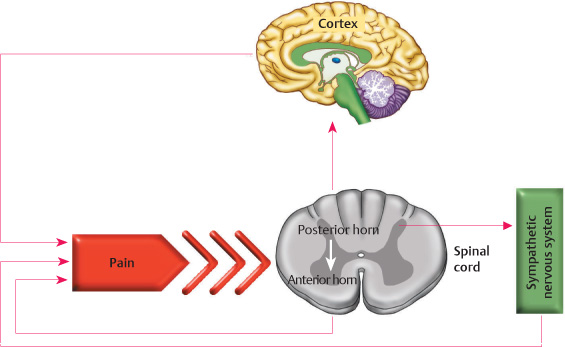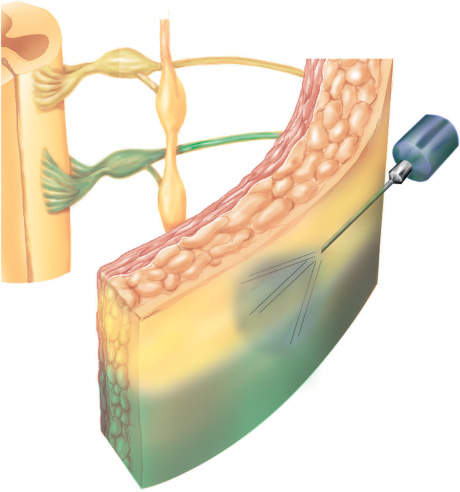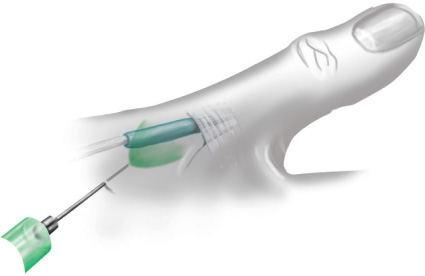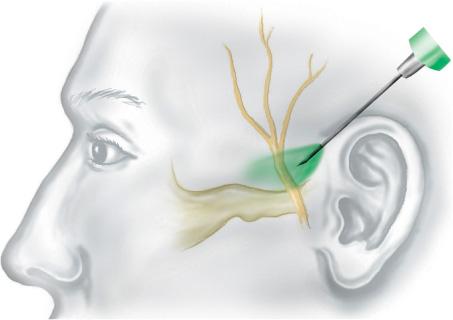1 Introduction Worldwide, pain is the main reason for patients to seek medical care. It is much more difficult to encourage patients to enter treatment if a disorder is not accompanied by pain; hence, pain treatment is one of the main responsibilities of a therapist. Regardless of whether the practitioner is a physician, physical therapist, naturopath, athletic coach, psychologist, or “green witch,” the one who masters pain control the fastest and most effectively receives the most recognition. In this respect, pain is not considered a homogenous formation but a collection of diverse sensations. Everybody knows light or stabbing pain, pain that can be precisely located, often involving the skin. This pain is transmitted via fast A delta fibers. On the other hand, there is the very dull, drawing pain, which is difficult to locate. This pain is transmitted via C fibers—unmyelinated, very slow acting nerve fibers. The first pain relay occurs in the spinal dorsal horn, where three different paths can be activated: the direct and shortest path to the spinal ventral horn, the path to the lateral horn, or the path via the medulla oblongata and brainstem ascending to the cortex can be chosen (Fig. 1.1). Corresponding to the path chosen, very different reactions occur: Fig. 1.1 Pain conduction and pain relay. The therapeutic approaches for pain treatment are as multifarious as their therapists. There are four fundamental possibilities: When a therapeutically effective stimulation is placed outside the location of pain origin and produces a reflexive reaction at the location of pain origin, one speaks of reflex therapy. Reflex therapies play a significant role in pain treatment. Examples for this type of therapy include manual medicine, acupuncture, physical-balneological treatments, and injection treatments. There are frequent arguments about definitions—trigger points, reflex points, connective tissue zones, acupuncture points, spheres, and central pain are terms used for synonymous domains and distract from the fact that everyone refers to the same reflex phenomenon to achieve improvement. Hereafter, we will not try to clarify this controversy, nor will we get lost in definition attempts ourselves, but would like to offer extracts from empirical knowledge about different areas that can be applied in daily practice. In pain therapy through local anesthesia, four different application methods are distinguished: 1. Segmental therapy 2. Local therapy 3. Interference field therapy (special local therapy) 4. Blockage of conduction pathways Segmental therapy is based on the fact that each neural segment of the spinal cord correlates developmentally with a particular zone of the skin and the connective tissue (dermatome), a particular zone of the musculature (myotome), and a particular zone of the skeletal system (sclerotome) (Fig. 1.2). Owing to the relay of neural fibers within the segment, interference can act crosswise. Thus, through treatment of the corresponding dermatome, for example, quaddle therapy, internal organs relating to the segment can be affected. Conversely, disorders of the correlating organs affect the respective myotomes and dermatomes. It is also possible to affect internal organs through the respective myotome or sclerotome. Local therapy takes place directly at the site of the diseased tissue or organ. A typical example is the injection into tendons or muscle insertions, or injections in articular capsule dysfunctions (Fig. 1.3). Interference field therapy treats zones with derailed tissue reaction. It is also a local therapy, generally treating injured and cicatricial areas, or areas affected by chronic inflammatory conditions. Unlike in the classic local therapy, these local interference fields (foci) can cause disorders away from the actual interference field without any neural connection. This type of chronic interference field can frequently be found in places of the tooth–mouth–pharynx space, for example, chronic tonsillitis or radicular foci. Surgical scars can also cause distant disturbances. Through injections under and around the focus, secondary disturbances can be eliminated (Fig. 1.4). Local anesthesia to the conduction pathways includes injection and flooding of the neural path directly with a local anesthetic. In this case, pain conduction is interrupted through injection to the peripheral nerves (Fig. 1.5). Fig. 1.3 Technique for local treatment. Fig. 1.5 Conduction pathway therapy; in this case, perineural flooding of a nerve. Arterial and venous pathways are treated in the same way. Caution: intra-neural and intra-arterial injections must be avoided. Even though our primary goal is pain elimination when injecting local anesthetics, we have to be aware that the local anesthetic produces several additional effects. The most important effects of local anesthetics are listed as follows: Every therapist who begins the use of reflex therapy through the injection of local anesthetics will be quickly convinced of the efficacy of this method and include it in his or her repertoire of routine treatments. In spite of routine and everyday occurrence in regard to this treatment, each injection has to be performed with due diligence. Injection therapy is one of the most effective reflex therapies. To perform injection therapy successfully, the following six principles have to be observed:
 Physiology of Pain Development
Physiology of Pain Development
 The relay toward the ventral horn produces increased tension in the associated muscles. For example, this causes the hand to pull away when burning is sensed before pain is experienced.
The relay toward the ventral horn produces increased tension in the associated muscles. For example, this causes the hand to pull away when burning is sensed before pain is experienced.
 The relay toward the sympathetic complex in the lateral horn produces a vegetative response, that is, changes in blood circulation, connective tissue tension, or the pain threshold.
The relay toward the sympathetic complex in the lateral horn produces a vegetative response, that is, changes in blood circulation, connective tissue tension, or the pain threshold.
 The relay toward brainstem, thalamus, and cortex produces the actual pain sensation, including its individual interpretation, phenomena of pain projection, and highly complex facilitating and inhibiting concomitant phenomena.
The relay toward brainstem, thalamus, and cortex produces the actual pain sensation, including its individual interpretation, phenomena of pain projection, and highly complex facilitating and inhibiting concomitant phenomena.
 Therapeutic Possibilities
Therapeutic Possibilities
 Pain treatment at the location of origin
Pain treatment at the location of origin
 Pain treatment along the conduction pathways
Pain treatment along the conduction pathways
 Pain treatment at the location of perception
Pain treatment at the location of perception
 Pain treatment at the location of secondary effect
Pain treatment at the location of secondary effect
 Methods for Application of Local Anesthetics
Methods for Application of Local Anesthetics
 Effects of Local Anesthetics
Effects of Local Anesthetics
 Pain elimination
Pain elimination
 Anti-inflammatory effect
Anti-inflammatory effect
 Sealing capillaries
Sealing capillaries
 Antihistaminic effect
Antihistaminic effect
 Antiallergenic effect
Antiallergenic effect
 Injection Techniques
Injection Techniques
Stay updated, free articles. Join our Telegram channel

Full access? Get Clinical Tree













